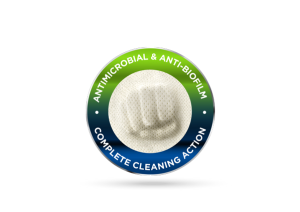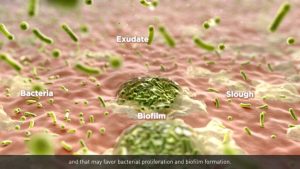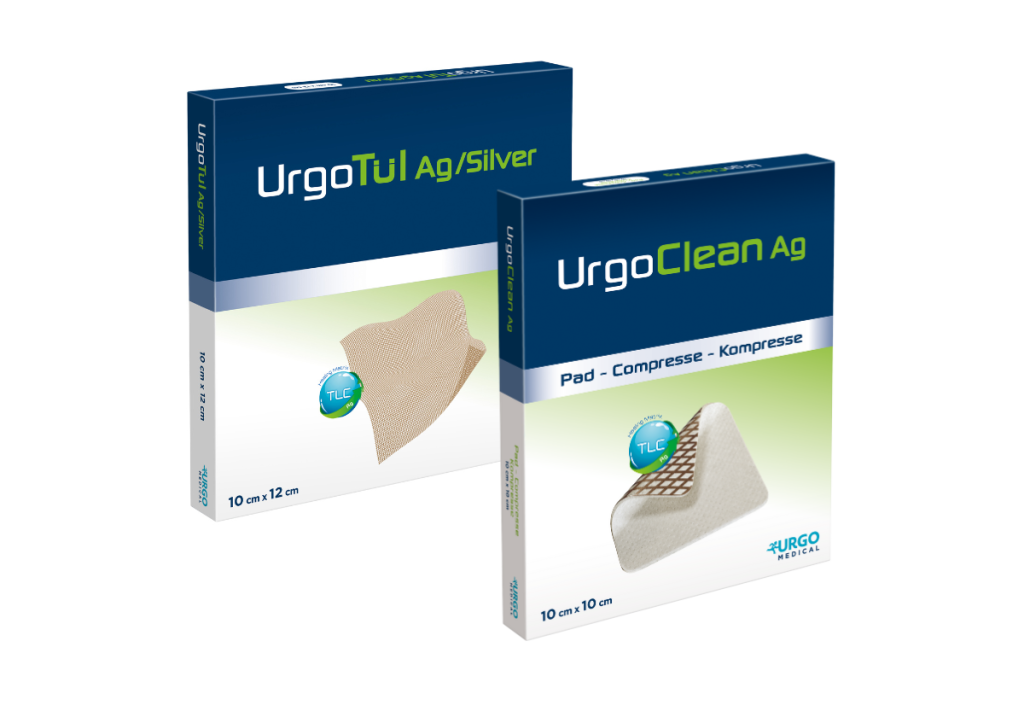 In contact with the wound exudate, the TLC-Ag matrix forms a gel, creating a moist environment that promotes wound healing.
In contact with the wound exudate, the TLC-Ag matrix forms a gel, creating a moist environment that promotes wound healing.
Simultaneously, the hydro-desloughing, polyabsorbent polyacrylate fibres absorb excess exudate, forming a gel. These hydro-desloughing fibres bind to the sloughy residues, absorbing and draining them in order to facilitate autolytic debridement.
This binding and drainage of slough by the hydro-desloughing structure of UrgoClean Ag combined with its Silver healing matrix (TLC-Ag) thereby promotes the desloughing phase of sloughy wounds, and aids management of minor bleeding (particularly after mechanical or surgical debridement).
In addition, the Ag+ ions give UrgoClean Ag an antibacterial activity that could help reduce the local bacterial load. The Ag+ ion has broad-spectrum antimicrobial activity, and is particularly effective against Staphylococcus aureus, MRSA, Streptococcus pyogenes and Pseudomonas aeruginosa (pyocyanic bacillus), the microorganisms most commonly implicated in infected wounds. The antibacterial activity of the dressing helps reduce odour caused by microorganisms present in the wound. UrgoClean Ag reduces the bacterial population of the biofilm within 24 hours and for 7 days (tested in vitro on S.aureus and P.aeruginosa).

The dressing is practical for patients, because it can be removed in one piece due to the tensile strength of the hydro-desloughing fibres. The gel formed does not stick to the wound, making it easy to remove the dressing, painlessly or with only minor pain and with little or no damage to healed tissue.
- Broad spectrum antibacterial activity, including MRSA (1)
- 99.9% removal of biofilms after 1 day (2)
- Pain-free dressing changes (3,4,5,6)
- Well-tolerated (7)
- Moist wound-healing (3,8)
- Clinically proven in a Randomised Controlled Trial (7)
 Contraindications:
Contraindications:
- Known sensitivity to silver.
- UrgoClean Ag is not suitable for use as a surgical sponge for heavily bleeding wounds.
- Do not combine UrgoClean Ag with hydrogen peroxide or organic mercury or hexamidine antiseptics.
- Do not leave the dressing in place on the patient during Magnetic Resonance Imaging exams (MRI scan).
Indications:
- Non to low exuding wounds, infected or at risk of infection
- Can be combined with an absorbent layer
- Can be used in cavity wounds

- Wound preparation:

- Clean the wound with normal saline. In the event of prior use of an antiseptic (except contraindicated antiseptics), rinse the wound carefully with normal saline before applying the dressing.
- The use of UrgoClean Ag does not dispense with the need for associated mechanical debridement when required.
- During desloughing, the wound may appear to get larger due to gradual elimination of slough.
- Dressing application:
- Remove the protective tabs.
- Apply with the micro-adherent side of UrgoClean Ag in contact with the wound and its edges.
UrgoClean Ag can be cut using sterile scissors to adjust the dressing size to fit the wound if necessary.
- If necessary, cover UrgoClean Ag with a secondary dressing suitable for the wound location and level of exudate.
- Secure in place with a suitable bandage or tape.
- Apply a compression bandage where prescribed.
- Dressing changes:
UrgoClean Ag should be changed every 1 to 2 days during the wound desloughing phase, then as often as required (up to 7 days) depending on the exudate volume and the clinical condition of the wound. The maximum treatment duration with UrgoClean Ag is 1 month.
Precautions for use:
- Treatment with UrgoClean Ag should be performed under medical supervision.
- The use of this dressing does not dispense with the need for appropriate systemic antibacterial treatment for infected wounds, in accordance with local treatment protocols.
- The silver-impregnated micro-adherent healing matrix (TLC-Ag) in UrgoClean Ag sticks to latex surgical gloves. It is therefore recommended that the dressing be handled carefully, avoiding any contact with the micro-adherent side, or using sterile tongs.
- The concomitant use of other local treatments is not recommended.
- Avoid contact with electrodes or conductive gels during electronic measurements, such as EEG or ECG recordings.
- Clinicians and healthcare professionals must take into account the fact that data concerning the prolonged and repeated use of a silver dressing, particularly in children and newborn babies, is not very extensively documented.
- In the absence of specific clinical data, the use of the UrgoClean Ag dressing during pregnancy or breastfeeding or in newborn or premature babies is not recommended.
- UrgoClean Ag must not be used during hyperbaric oxygen chamber therapy without an oxygen mask (risk of combustion due to the presence of fat). This contraindication does not apply for hyperbaric oxygen chamber therapy with an oxygen mask if the oxygen concentration inside the chamber is less than 25% and if UrgoClean Ag is not applied on the area over which the mask is placed.
- Sterile individual packaging, for single use. Reuse of a single-use dressing can lead to risks of infection.
- Check that the sterility protector is intact before use. Do not use if the packaging is damaged.
- Do not re-sterilise.
- For disposal, refer to the existing protocol. Discard any unused parts of the dressing.
Method of use:
- Add a secondary dressing
- Secure with a retention bandage (K-Band, K-Lite)
- Can be left in place for up to 7 day
(2) Bernard FX et al. Effets d’un pansement lipidocolloïde sur la production de matrice extracellulaire. Journal des Plaies et Cicatrisations, 2007 (study conducted on Urgotul).
(3) Bernard FX et al. Stimulation of the proliferation of human dermal fibroblasts in vitro by a lipidocolloïd dressing. Journal of Wound Care, May 2005; 14 (5): 215-220 (study conducted on Urgotul).
(4) Le Berre. Y. Lurton et al., Pansments imprégnés : tulles/interfaces. CPC 2005 poster, Paris
(5) Meaume S et al. The importance of pain reduction through dressing selection in routine wound manager the MAPP study. Journal of Care 2004, vol 13, No 10, 409-413 (study conducted on UrgoTul).
References:
*Excluding dry necrosis.
**TLC-NOSF: Lipido-Colloid technology – Nano OligaSaccharide Factor (KSOS: Potassium octasulfate sucrose salt).
1. National Institute for Health and Care Excellence (NICE), UrgoStart for treating leg ulcers and diabetic foot ulcers, https://www.nice.org.uk/guidance/mtg42, April 2023
2. Report to the French minister responsible for Social Security and the French Parliament concerning the evolution of French National Health Insurance charges and products for 2014. July 2013. CNAM database: leg ulcers: 210 days; pressure ulcers: 223 days; diabetic foot ulcers: comparative data not available.Edmonds M et al. Sucrose octasulfate dressing versus control dressing in patients with neuroischaemic diabetic foot ulcers (Explorer): an international, multicentre, double-blind, randomised, controlled trial. Lancet Diabetes Endocrinol. 2018 Mar; 6(3): 186-196.
3. Lázaro-Martínez JL et al. Optimal wound closure of diabetic foot ulcers with early initiation of TLC-NOSF treatment: post-hoc analysis of Explorer. J Wound Care. 2019 Jun 2; 28(6): 358-367.
4. Münter KC et al. The reality of routine practice: a pooled data analysis on chronic wounds treated with TLC-NOSF wound dressings. J Wound Care. 2017 Feb; 26 (Sup2): S4-S15. Erratum in: J Wound Care. 2017 Mar 2; 26(3): 153.
5. Report to the French minister responsible for Social Security and the French Parliament concerning the evolution of French National Health Insurance charges and products for 2014. July 2013. CNAM database: leg ulcers: 210 days; pressure ulcers: 223 days; diabetic foot ulcers: comparative data not available.
6. Meaume S et al. A randomized, controlled, double-blind prospective trial with a Lipido-Colloid Technology-Nano-OligoSaccharide Factor wound dressing in the local management of venous leg ulcers. Wound Repair Regen. 2012; 20(4): 500-511.
7. Dissemond J. et al. Clinical evaluation of polyabsorbent TLC-NOSF dressings on chronic wounds: a prospective, observational, multicentre study of 1,140 patients. J Wound Care. 2020; 29(6): 350-361.
8. CAV III: in non-infected (IDSA/IWGDF infection criteria) neuro-ischaemic diabetic foot ulcers (non-critical ischaemia), in the granulation phase (sequential treatment).
9. In the treatment of diabetic foot ulcers. IWGDF Guidelines on the prevention and management of diabetic foot disease, 2019UrgoStart Plus Pad: Class IIb medical device (G-Med; 0459). Treatment to reduce healing time. LPPR fully reimbursable (Social Security: 60% + top-up mutual insurance: 40%) in the treatment of venous or mixed, predominantly venous leg ulcers in the granulation phase (sequential treatment), and in non-infected (IDSA/IWGDF infection criteria) neuro-ischaemic diabetic foot ulcers (non-critical ischaemia), in the granulation phase (sequential treatment). Read the leaflet carefully before use, particularly the precautions for use and contraindications.Manufacturer: Laboratoires URGO – 12/2020.
1. National Institute for Health and Care Excellence (NICE), UrgoStart for treating leg ulcers and diabetic foot ulcers, https://www.nice.org.uk/guidance/mtg42, April 2023
2. “In vitro” study. Internal Report. Laboratoires URGO.
3. Edmonds M, Lázaro-Martínez JL, Alfayate-García JM, Martini J, Petit JM, Rayman G, Lobmann R, Uccioli L, Sauvadet A, Bohbot S, Kerihuel JC, Piaggesi A. Sucrose octasulfate dressing versus control dressing in patients with neuroischaemic diabetic foot ulcers (Explorer): an international, multicentre, double-blind, randomised, controlled trial. Lancet Diabetes Endocrinol. 2018 Mar;6(3):186-196.
4. Sigal ML, Addala A, Maillard H, Chahim M, Sala F, Blaise S, Dalac S, Meaume S, Bohbot S, Tumba C, Tacca O. Clinical evaluation of a new TLC-NOSF dressing with poly-absorbent fibers for the local management of exuding leg ulcers, at the different stages of the healing process: Results from two multicentric, single-arm, prospective, open-label clinical trials. J Wound Care 2019: 28(3) :164-175
5. Meaume S, Dissemond J, Addala A. Evaluation of two fibrous wound dressings for the management of leg ulcers: results of a European randomised controlled trial (EARTH RCT). J Wound Care 2014; 23: 3, 105–116.
6. Meaume S, Truchetet F, Cambazard F et al. A randomized, controlled, double-blind prospective trial with a Lipido-Colloid Technology-Nano-OligoSaccharide Factor wound dressing in the local management of venous leg ulcers. Wound Repair Regen. 2012; 20: 4, 500–511.
7. Münter KC, Meaume S, Augustin M, Senet P, Kérihuel J.C. The reality of routine practice: a pooled data analysis on chronic wounds treated with TLC-NOSF wound dressings. J Wound Care. 2017 Feb; 26 (Sup2): S4-S15. Erratum in: J Wound Care. 2017 Mar 2; 26(3): 153
8. Dissemond J, Lützkendorf S, Dietlein M, Neßeler I, Becker E, Möller U, Thomassin L, Bohbot S, Münter KC. Clinical evaluation of polyabsorbent TLC-NOSF dressings on chronic wounds: a prospective, observational, multicentre study of 1140 patients. J Wound Care. 2020 Jun 2;29(6):350-361. doi: 10.12968/jowc.2020.29.6.350. PMID: 32530781.
9. Augustin M, Keuthage W, Lobmann R, Lützkendorf S, Groth H, Möller U, Thomassin L, Bohbot S, Dissemond J, Blome C. Clinical evaluation of UrgoStart Plus dressings in real-life conditions: results of a prospective multicentre study on 961 patients. J Wound Care. 2021 Dec 2;30(12):966-978. doi: 10.12968/jowc.2021.30.12.966. PMID: 34881999.
10. Lazaro et al . Optimal wound closure of diabetic foot ulcers with early initiation of TLC-NOSF treatment: post-hoc analysis of Explorer.JWC VOL 28, NO 6 , June 2019
11. Report to the French minister responsible for Social Security and the French Parliament concerning the evolution of French National Health Insurance charges and products for 2014. July 2013.
12. CAV lll: in non-infected (IDSA/IWGDF infection criteria) neuro-ischaemic diabetic foot ulcers (non-critical ischaemia, in the granulation phase (sequential treatment)
13. IWGDF – Guidelines on the prevention and management of diabetic foot disease – 2019.
1. Report to the French minister responsible for Social Security and the French Parliament concerning the evolution of French National Health Insurance charges and products for 2014. July 2013.
2. Edmonds M, Lázaro-Martínez JL, Alfayate-García JM, Martini J, Petit JM, Rayman G, Lobmann R, Uccioli L, Sauvadet A, Bohbot S, Kerihuel JC, Piaggesi A. Sucrose octasulfate dressing versus control dressing in patients with neuroischaemic diabetic foot ulcers (Explorer): an international, multicentre, double-blind, randomised, controlled trial. Lancet Diabetes Endocrinol. 2018 Mar;6(3):186-196.
3. Meaume S, Truchetet F, Cambazard F et al. A randomized, controlled, double-blind prospective trial with a Lipido-Colloid Technology-Nano-OligoSaccharide Factor wound dressing in the local management of venous leg ulcers. Wound Repair Regen. 2012; 20: 4, 500–511.
4. Meaume S, Dompmartin A, Lazareth I, Sigal M, Truchetet F, Sauvadet A, Bohbot S. Quality of life in patients with leg ulcers: results from CHALLENGE, a double-blind randomized controlled trial. Journal of Wound Care. 2017; 26 (7): 368-379.
5. Münter KC, Meaume S, Augustin M, Senet P, Kérihuel J.C. The reality of routine practice: a pooled data analysis on chronic wounds treated with TLC-NOSF wound dressings. J Wound Care. 2017 Feb; 26 (Sup2): S4-S15. Erratum in: J Wound Care. 2017 Mar 2; 26(3): 153.

